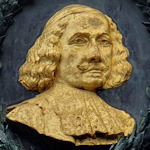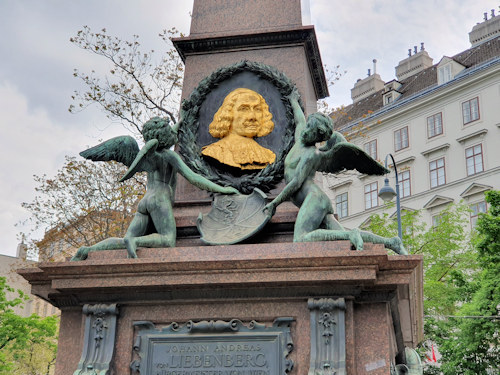
Most historical monuments in Vienna honour monarchs and musicians, with a few soldiers, writers and artists thrown in for good measure. The Liebenberg monument is one of the exceptions.
- Honours Liebenberg’s role as mayor during the siege of Vienna
- Granite and bronze work unveiled in 1890
- Book a themed guided tour* of Vienna
- See also:
A mayor for trying times

(The monument with the Pasqualatihaus behind on the right)
Where the UK has 1066, Vienna has 1683.
That year, the Ottoman empire laid siege to the city and came THIS close to taking the jewel of the Habsburg empire. The change of ownership would have sent European history off in a completely different direction.
The Ottoman defeat came about through the arrival of a relief army led by the Polish king Jan Sobieski. But the city’s survival until then owed much to the endurance of its population and the leadership of its mayor: Johann Andreas von Liebenberg (1627-1683).
(Incidentally, Liebenberg never lived to see Vienna’s triumph. He died a couple of days before Sobieski’s arrival.)
Fast forward to just prior to the 200th anniversary of the siege. As you can imagine, the date had various factions floating different ideas about how best to commemorate the momentous occasion.

(The obelisk is made of Swedish granite)
One of the ideas that eventually came to fruition (following a checkered history and the efforts of a private initiative) was to erect a monument to Liebenberg: an obelisk honouring his role in the eventual victory but with a latent nod of appreciation in the direction of Vienna’s citizens, too.
This might seem a rather obvious choice, but imperial Vienna was not used to simple citizens getting the kind of sculpted recognition normally afforded military leaders and Holy Roman Emperors.
The chosen location just off Mölkerbastei had a special resonance.
The site lay next to one of the very few parts of the old city walls still remaining; urban expansion post-1850 saw almost all the fortifications that held the Ottomans at bay replaced by the Ringstrassen roads.

(They allegedly positioned the lion closer to the plinth on the advice of Emperor Franz Joseph)
(A near neighbour on top of Mölkerbastei is the Pasqualatihaus, where Beethoven once lived. The area often features in period TV and film productions like Vienna Blood or The Woman in Gold.)
The grand buildings that went up around Vienna’s Ringstrassen kept many sculptors busy with statues and similar. One such artist was Johann Silbernagl, who designed the Liebenberg monument along with architect Franz von Neumann.
Both the obelisk itself and its stepped plinth are made of granite. One side has a bronze statue of a lion holding a paw on a battered Ottoman shield (an allegory that needs no explanation).

(The side reliefs have spoils/images of war)
That same side includes a portrait relief of Liebenberg with two bronze winged figures holding the laurel and oak wreath that rings the former mayor. An inscription below the relief reads:
Johann Andreas von Liebenberg, mayor of Vienna in the year 1683.
The reverse side has the city crest and an inscription expressing Vienna’s gratitude for its former leader’s courage and resilience under considerable hardship.
Decorative reliefs with military motifs and trophies mark the two other sides.

(Victoria in all her glory)
A bronze figure of Victoria, the winged Roman Goddess of Victory, tops the obelisk. She holds up another laurel wreath.
Work on the monument took several years, with the official handover to the city taking place on September 12th, 1890 (207 years to the day after the lifting of the siege).
According to a newspaper report of the time, the sun broke through the clouds just at the moment of the unveiling.
The guest list included Liebenberg’s descendants and leading officials of the empire, though Emperor Franz Joseph himself was in Hungary at the time. Not a snub, I think, given that the emperor made a sizeable donation to fundraising efforts for the monument.
Vienna has a further, though smaller, tribute to their former mayor elsewhere in the city. Liebenberg is one of the figures that revolves around the giant Ankeruhr mechanical clock over on Hoher Markt.
How to get to Liebenberg
The monument lies just a stone’s throw from Schottentor station, which is a stop on the U2 subway.
Schottentor is also the starting point for various tram lines (37, 38, 40, 41, 42, 43 and 44) and a stop on others (the 1, D and 71 trams that go at least part way around the Ringstrassen).
Address: Mölker Bastei 8, 1010 Vienna